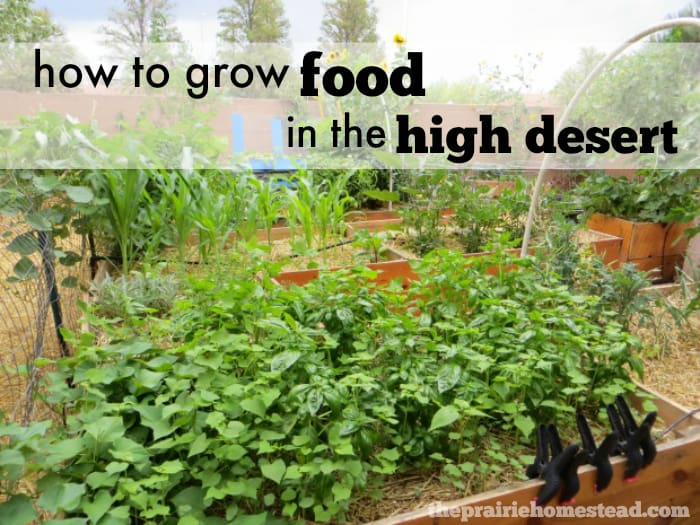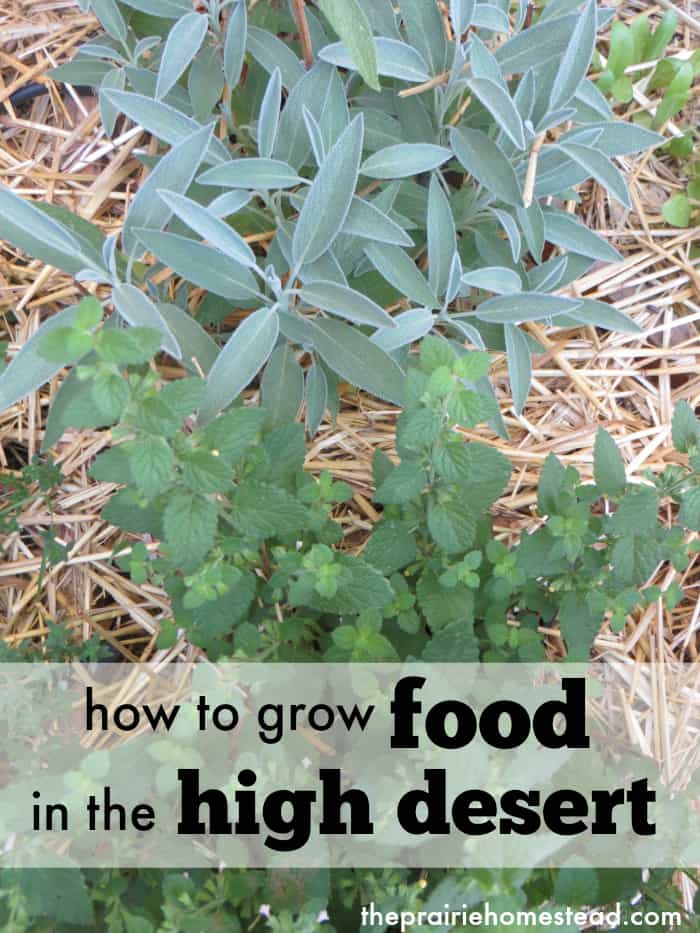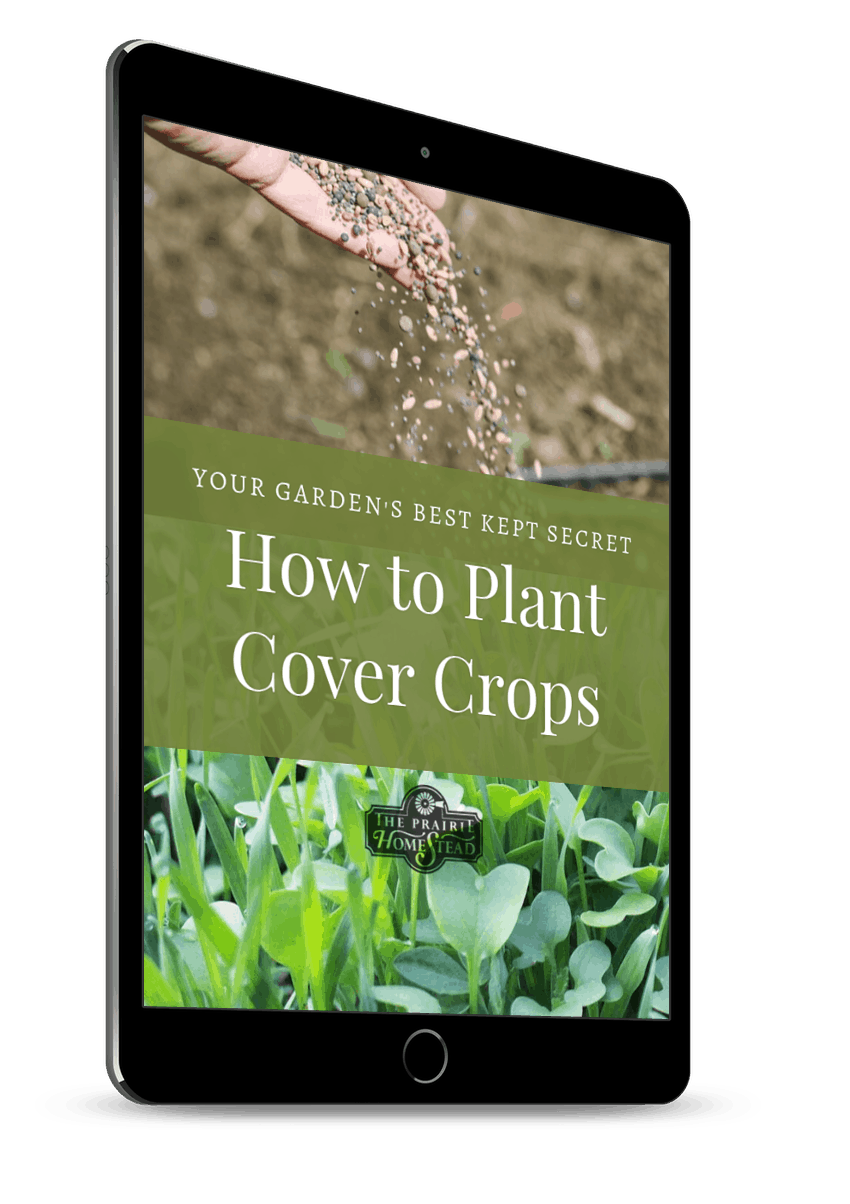Gardening In The Mojave Desert 101

Today I'm welcoming Melissa from Ever Growing Farm to the Prairie Homestead. We share the challenge of gardening in less-than-ideal climates, and I love her ideas for gardening in the desert. Take it away Melissa!
Growing food in the high desert can be an incredible challenge, but I am living proof that you can be successful at it! If you follow a few simple methods to help combat the hot, dry, and windy conditions that are the norm in the southwest, you can be almost guaranteed a bountiful harvest.
Six Tips for Successful Desert Gardening
1. Find the Right Seeds – Seeds that have been grown in and adapted to the high desert are going to be your best bet in the garden. There are countless heirloom varieties that have been protected by the companies that make it their life's work to preserve the history of our fruits and vegetables. Find them at your local nursery, Farmer's Market or order them online via NativeSeeds.org, Baker Creek Heirlooms or Seed Saver's Exchange.
2. Nurture the Soil– The soil in the high desert is full of sand, gravel, and clay and must be amended. Amend your soil with organic matter, such as compost from your own pile or from your local nursery, knowing this is the foundation of a successful garden. Amending, to some extent, will need to be done annually, and starting with your first planting.
You might also consider planting some cover crops during the off-seasons so as to continue building (and maintaining) your soil.
3. Commit to Lots of Water – The high desert has a unique, incredibly arid climate which not only affects plants at their roots, but also affects the plants ability to draw water in through their leaves. Given this, it is essential that, when watering your veggies, you optimize the amount of water they receive. The easiest ways to do this is through drip irrigation and heavily mulching your beds.
- Drip irrigation is a series of small hoses that allow water to literally drip slowly into the ground around the base of the plant and down into the root zone. The set up involves a network of tubing, pipes, valves, and emitters. Depending on how extensive your garden beds are, setting up your drip irrigation could take a few hours, but the end result is more than worth the effort put in at the beginning. Setting up drip irrigation will not only offer you peace of mind, knowing that your plants are getting the water they need, but it will also save you hours each week since you won't have to water everything by hand!
- Water catchment, in the form of rain barrels, can be a life saver (if it is legal in your state). Allowing the rain water to be diverted from your roof and into large barrels or cisterns on your property can help offset your water costs (or alleviate some of the stress on your well) when used to spot water plants that require a bit more water than others. Alternatively, you can set up your rain barrels with hoses and a gravity feed or a timer to water your plants, but that's another post entirely.
4. Mulch It!– Whether used in the form of straw, pulled weeds (before they go to seed) or the bags you can purchase from your local nursery, mulch pulls triple duty by
- Keeping weeds down
- Protecting the soil surface and the base of your plants form the elements
- Holding moisture in the soil
(Jill: If you're wanting to dig deeper into the topic of mulching, I highly recommend the deep mulch method. I'm going on my second year of using it our own difficult climate, and I am in love!)
5. Watch that Sun – The sun in the high desert can literally fry your vegetable plants due to the high altitude and the intense UV rays. In order to avoid burning our plants, I've found that the following two strategies work best:
- Companion Plant – Companion planting is usually thought of in relation to safeguarding against harmful pests, but it can also be utilized to shade lower growing plants beneath the taller, hardier plants. For example, you could grow kale or chard beneath a pole bean tee-pee.
- Shade Cloth – Shade cloth is a wonderful and fairly inexpensive way to protect your tender veggies form the sun's rays and baking heat. I've found that Summer and Winter Squash benefit greatly from a bit of shade at the hottest time of day! You can achieve this by simply inserting PVC pipes in your beds as you would when creating a hoop house or low tunnel and then securing your shade only over the very top of the PVC pipes using small clamps so your plants get some sun, just not the hottest sun of the day.
6. And the wind…The wind in the high desert can take a vegetable plant and lay it out flat in the course of just a few seconds! In order to protect your plants (and all of your hard work), creative windbreaks are essential.
Ideally, walls and/or; fencing can be constructed to protect your garden area. However, if that is unrealistic, straw bales can be placed around your garden area to protect your plants. Whether you surround the whole area, or simply create a wind break protecting your plants from the direction the winds usually travel in, every bit of protection is better than none!
We have tried trellising and supporting our plants, and are not opposed to it entirely, but have found that the wind is often stronger than any trellis we've put in place! The plants do survive, most of the time, but tend to be a bit worse for the wear.

Growing your own food in an extreme climate can be a bit intimidating, but it is absolutely doable by simply adding a few tips and tricks to your desert gardening arsenal! So, let's learn from each other!
Share your tips and tricks to growing food in your unique climate in the comments below.
Melissa Willis shares about her family's adventures in Urban Farming on 1/8 acre in the high desert of Santa Fe, NM on her blog Ever Growing Farm . With 20 laying hens, five fruit trees and 425 square feet of active growing space, every extra hour in the day goes into producing as much of their own food as possible and learning many of the old skills that have stopped being passed down from generation to generation. Melissa can also be found on Facebook, Instagram, Twitter or Pinterest

Your Garden's Best Kept Secret!
Cover crops are an incredibly underutilized, very affordable way to fertilize your soil, decrease erosion, and increase organic matter. Learn which crops are best for your garden, plus a step-by-step process so you know exactly WHEN and HOW to plant them! Grab the full-color cover crop PDF here (it includes my weekly Homestead Toolbox Newsletter, which gets rave reviews from busy homesteaders!)-->
Gardening In The Mojave Desert 101
Source: https://www.theprairiehomestead.com/2015/05/desert-gardening.html
Posted by: baileycoluch.blogspot.com

0 Response to "Gardening In The Mojave Desert 101"
Post a Comment